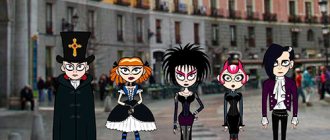Greetings, friends!
People tend to adopt moral values, habits and behavior patterns from those around them. In addition, they unite in groups, isolate themselves, trying to spend more time with those whose views on life are closest to them. Thanks to this, subcultures are formed - large groups of people united by common tastes, values, interests, views, aspirations or ideas. Today we will analyze in detail what subcultures are, what characteristics they have and what they are, and also consider several examples.
What is a subculture?
A subculture is a separate part of the main (dominant) culture, which stands out strongly against the general background. It can be formed on the basis of moral values, religious views, traditions, customs and other sociocultural characteristics. The most obvious example of a subculture is youth movements that unite fans of certain styles of music or a significant cultural phenomenon (for example, the works of Tolkien or Lovecraft).
To fully understand the term “subculture”, let’s also define the concept of “culture”. In simple terms, culture is the totality of all material and intangible values created by humanity. At the same time, we can talk about one universal culture, or we can distinguish the cultures of individual countries and peoples. In any case, it implies a set of universal values accepted by all representatives of a particular people, regardless of age, social status and other factors.
Most modern subcultures are youth subcultures, since teenagers and young adults are characterized by a low level of conformism (what is this?) and tolerance to the moral values that society imposes.
Countercultures are an important type of subculture. This is the name given to subcultures that are completely built on the denial of traditional values for a given society. Some authors believe that the term “counterculture” is appropriate whenever the primary element of identifying a subculture is based on opposition to the dominant culture.
Counterculture
Counterculture
A form (or type) of culture that actively opposes the “official” traditional culture.
Counterculture unites any form of deviant behavior. The concept of counterculture is close to the concept of alternative culture. In a narrower and more specific sense, the term “counterculture” is used to designate a form of protest against the culture of the “fathers” that spread among part of American youth in the 60s and early 70s of the 20th century (counterculture of the 60s). This neologism was first used in 1968 by Theodor Roschak . Familiarization with the works of counterculture theorists, for example Herbert Marcuse and Jean-Paul Sartre, makes it possible to better understand its socio-historical meaning.
In fact, the emergence of a counterculture is a completely natural phenomenon.
The dominant culture, which is opposed by the counterculture, organizes only part of the cultural space of a given society. It is not capable of covering all the diversity of phenomena. Moreover, in every dominant culture there are always significant outdated elements. They do not meet the needs of today and are only imitated by tradition or habit. Therefore, by pointing out such elements, counterculture can also play a positive cultural role. This was Christianity in the first centuries of its history, which, before being proclaimed in the 4th century. n. e. the official religion of the Roman Empire, was persecuted precisely as a counterculture, hostile to the dominant culture based on pagan religion.
How did the term come about?
The term “subculture” is derived from the Latin words sub (under) and cultura (culture). Therefore, in the Russian language the word “subculture” can be used on an equal basis with it. This term is used in political science, sociology, philosophy, anthropology and many other sciences, in which it can be interpreted somewhat differently. It is important not to confuse subcultures with youth communities consisting of young people with common interests.
This concept was introduced by the American sociologist David Riesman. He gave it the following definition: a subculture is a certain social group that demonstratively chooses moral values, an appearance style and manners that do not correspond to the generally accepted ones. This phenomenon was later studied by British sociologist Dick Habdige. He noted that subcultures include people united by common tastes and at the same time dissatisfied with the norms accepted in their society.
Interestingly, in the 20th century, many authors used alternative terms to refer to this phenomenon. Thus, the French sociologist Michel Maffesoli calls youth subcultures “urban tribes,” and the Soviet biologist Viktor Dolnik uses the term “clubs.” In the USSR, the concept of “informal youth associations” was widely used, and their representatives were called “informals.” Around the same time, the slang word “tusovka,” which is still popular today, appeared.
Signs of a subculture
In most cases, representatives of subcultures seek to emphasize their belonging to a particular movement. This is manifested in their habits, behavior, speech patterns and appearance. They listen to certain styles of music and often reject other styles, even if they do not have an aesthetic dislike for them.
Most subcultures are characterized by the presence of such elements as:
- special lifestyle and behavior;
- own set of moral values and views;
- characteristic features of appearance;
- nonconformism;
- low tolerance for universal values and high for values accepted within the movement.
Usually subcultures are apolitical, and their representatives emphasize their apoliticality. But it also happens that they adhere to certain political views, which they express in a rather harsh form. A subculture can be closed and strive to isolate itself from society as much as possible, or it can behave defiantly, demonstrating protest against accepted norms in society or some significant events. Many subcultures have their own press and public organizations.
Why is this environment so attractive?
In addition, being part of one or another informal movement takes up teenagers’ time, teaches them to structure their own leisure time and, ultimately, leads to greater organization.
Let us note that a very considerable number of young people lack a clearly defined personal self-identification. Most of them are at the mercy of behavioral stereotypes, which ultimately leads teenagers into the ranks of informals. Any youth counterculture is 80-90% made up of imitators who are incapable of defending their own individuality.
The simplest reason for teenagers joining representatives of a particular subculture is the search for people who are similar in their beliefs. Shocking, as well as external attributes, are secondary in comparison.
Youth subcultures
Teenagers and young people always demonstrate nonconformity towards the older generation - this is inherent in human nature. Therefore, it is in the youth environment that new cultural movements usually arise, using the example of which it is most convenient to explain what a subculture is. It is important to understand that modern youth do not perceive work as a central part of their lives. Much more important to them is how they spend their leisure time.
Youth subcultures are characterized by the following features:
- use of slang;
- group conformism (the opinion of the “party” is taken as one’s own);
- a special style of clothing, and sometimes hairstyle;
- interest in certain types of art (for example, anime);
- characteristic type of behavior;
- the desire to emphasize one’s informality.
Youth subcultures are characterized by a surrogate character. Their representatives fill their lives with substitutes for real values. For example, they protest against the will of their parents, pretending to be independent , although they are not yet ready for an independent life. Quite often, protest against the norms of the older generation is expressed in smoking, drinking alcohol and drugs.
Anime fans and cosplayers
Another type of youth subculture is otaku. It is based on a love of Japanese animation and manga (Japanese comics). Participants in this movement not only passively watch cartoons, but also create their own, organize festivals and cosplay competitions.
Cosplay is the act of impersonating a specific character from an anime, manga, film or computer game. This is not only an authentic costume and hairstyle; many people use art makeup to achieve a complete resemblance to the chosen hero.
Representatives of this type of subculture can be recognized by their bright hair and paraphernalia with their favorite characters. But again, not everyone copies the appearance of their favorite heroes in everyday life.
The otaku movement in Russia is characterized by specific slang based on the use of Japanese words. These can be both common phrases - “arigato” - “thank you”, “sayonara” - “goodbye”, and specific ones: “kawaii” - “cute”, “adorable”, or “nya” - expressing a huge range of emotions.
The age composition of anime fans is diverse - these include 15-year-old teenagers and people 20-30 years old.
Examples of subcultures
To finally understand what a subculture is, let's look at a few examples. In general, there are a huge number of them and new ones are constantly appearing. However, in history there are several of the most striking subcultural movements that were not only popular, but also had a significant impact on global historical events. Let's look at a few of the most famous ones.
Punks
This subculture originated in the 1970s in Great Britain. The country could not overcome the severe economic crisis; young people could not find work and did not understand what to do next. Because of this, they had the slogan “No future!”, which became the motto of the subculture. The idea behind this movement was that the situation was already so bad that it was simply impossible to make it worse. Punks were not particularly law-abiding, because they believed that they had nothing to lose.
Goths
This movement arose under the influence of punk culture and adopted a lot from it. Goths also disdain education and any personal development. At the same time, they behave more restrained than punks, and do not strive for such a colorful appearance. Their appearance is predominantly black. They choose black clothes and accessories, dye their hair black, and use black makeup.
Emo
This is the most emotional subculture, because its name is derived from the word “emotions”. Emos listen to special music and dress in such a way as to create the most dramatic and emotional image. They are also characterized by specific hairstyles and heavy makeup, emphasizing the size and shape of the eyes. Their appearance is dominated by black and pink.
Hippie
This is a special philosophy and subculture that emerged in the USA in 1965. This movement was a response to the realities of that time - the participation of the United States in the Vietnam War, the still existing racial segregation and other manifestations of inequality. Hippies stood for peace, freedom, love, tolerance and equal rights. It was they who came up with the famous motto of American youth of that time: “Make love, not war.”
Skinheads
This is an ultra-right youth movement whose supporters held nationalist or even openly Nazi views. Skinheads appeared in Britain in the 1980s. This subculture usually included aggressive young people who were prone to xenophobia and generally intolerant of anyone who was somehow different from them. Many of them were imbued with Hitler's ideas and believed that the white Aryan race should dominate the world.
Skinheads were the most aggressive of the youth subcultures. They attacked representatives of national or sexual minorities and, in general, anyone who was different from them in some way. During such attacks, they did not hesitate to use edged weapons and often inflicted mortal wounds on their victims. In the 2000s, this movement was also popular in Russia, but today there is little left of it.
Yuppie
This is a subculture of successful young people who are highly paid professionals in a certain field of activity. As a rule, these are people who have just graduated from university. They don’t have a family yet, and they can spend everything they earn on themselves. Therefore, they are always dressed to the nines, buy top-end smartphones on the day of the presentation, and keep up with current events and new products. Yuppies pay attention to health, go to the gym, run in the morning, and often become vegetarians.
Features of socialization of the younger generation
Note 1
Socialization is a multifaceted and continuous process that accompanies a person throughout his life. However, in adolescence this process occurs most intensively, since at this time social norms are learned, value orientations are laid, and the motivation for social behavior is formed.
The formation of social maturity in the younger generation occurs under the influence of the family, immediate environment, school, spontaneous groups, youth organizations, the media, etc. This is a period when boys and girls strive to prove their social maturity, uniqueness, and want to stand out from the crowd of people.
Young people are the first to accept innovations (both positive and negative) in various spheres of life.
Socialization of youth has its own characteristics:
- The authority of adults is noticeably reduced, and the reference group takes a significant place. The dual position of a young man: on the one hand, he is required to be independent, and on the other hand, he is under the constant control of adults, which leads to the development of conflict situations. The dominant role in socialization is played by Internet resources, television, and communication with peers. Communication with peers acts as a specific type of emotional contact, as an activity that provides the conditions for the formation of value orientations.
- The formation of self-awareness and self-expression, manifested in attempts to develop a new, often opposite worldview for adults, rejection of children's rules of behavior.
- Characteristic features are a decreased sense of fear and a tendency to take risks, and the search for new, more non-standard and risky forms of behavior and activity.
The listed features leave an imprint on the nature of behavior, the psyche of a young person, and the formation of an attitude towards the surrounding reality. There is a need to realize what features of his personality contribute (or hinder) to realize himself, to show his uniqueness; the need to evaluate one's capabilities.
All needs are embodied in the desire to find oneself in any association, in particular, in a subculture.









